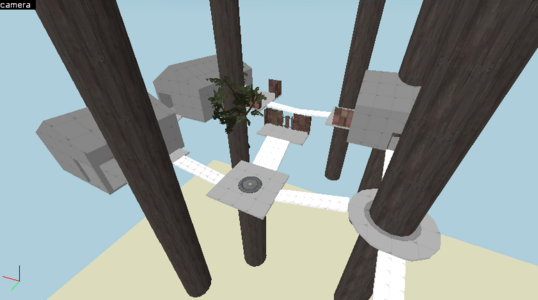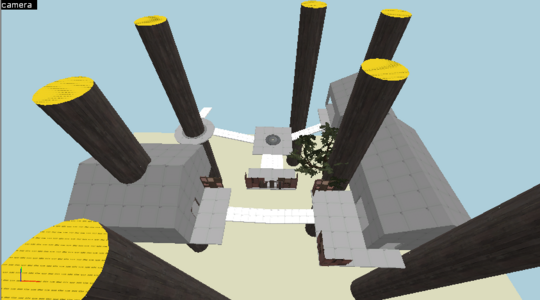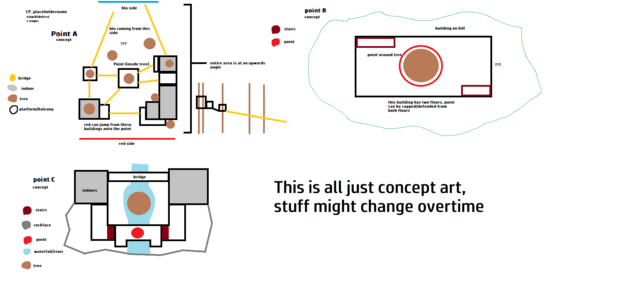Hi,
Not sure if you've already received a reply on Discord or not, but here's my two cents:
Connecting A/D points typically involves a lot more thought than just building a certain stretch of distance between them.
The distance between the points is heavily dependent on where RED spawns while defending each point - if RED spawns far away, then the point must be far from the previous point.
The overall goal is to separate the defense of each point into a "forward hold" and "backward hold" - the idea is that after A is captured, RED respawns and walks to B, and the point where they meet BLU should be at the forward hold, so that if BLU ubers into them, they can fall back on the backward hold and the point isn't just a total steamroll.
Here's a diagram of the forward and backward hold on one of Dustbowl's points:
In typical defenses of this stage, RED will be waiting at the forward hold area after A is captured, and the point will take a reasonably long time to be captured.
Some steamrolls are unavoidable, of course, but that's only if BLU is full of crazy good players and RED just loses fight after fight after fight.
One thing that can really help is using a game_forcerespawn entity, and sending it a "ForceTeamRespawn 2" output when A is captured, so all RED players will be alive and walking to B the moment A is captured - this can reduce the amount of distance you need to build between A and B.
Also note that I'm using "A and B" here for ease of understanding - this is just as applicable for the space between A and B as the spawn between B and C.
What I usually do in my early-development maps is design each of the control points (complete with forward hold, backward hold and RED's spawn for that point) in an isolated VMF, then when I dump them into a combined VMF, I measure (with brushes) the amount of time it takes for RED to reach that point's forward hold out of spawn.
This is as simple as drawing a brush where one corner is in RED's spawn and one corner is in the forward hold, then using the Pythagorean ratio to find the absolute distance between those two points (in hU), and dividing it by 300 (because the average TF2 class walks 300 hU/second) to get the number of seconds it takes to walk that far.
Usually I also add a second or two, cause this walk is rarely an actual straight line like the brush that measures it.
Here's an example of this walk time sheet:
These measurements allow me to place the points relatively to each other, so that from the backward hold of one point, it takes BLU a certain amount of time to reach the forward hold of the next point -
Specifically, the same amount of time it takes RED to reach that same forward hold, or a couple seconds less at most.
That way, with the instant respawn we gave RED, we
know for sure that RED will always reach the forward hold in time to not make the point a total steamroll.
There are also layout-design considerations. For instance, we don't really want RED to be able to hold the "dead-space" between the two points (because it'll make it feel like BLU didn't have a fair amount of time to attack the next point compared to if RED hadn't done this), so we have to design it very specifically to prevent that. Here's an illustration of pl_boatload as an example:
At some point in development, I noticed that RED would often hold the area highlighted in red, and that I didn't really want that.
So I added that area on the right - if RED tries holding the area highlighted in red, BLU can use this new route to get behind them and form a devastating pincer attack.
In order to prevent this, RED is forced to fall back and hold the area highlighted in pink.
Another consideration is where we should spawn BLU.
It's essentially a no-brainer that you shouldn't spawn BLU too far from the point they're supposed to be attacking - but how far is "too far"?
Thankfully, we have the forward hold and backward hold to inform us about this.
Usually, before the forward hold, you have an area called the "lobby", which is the permanent area BLU will use to attack the forward hold - you never really want RED to be able to push into and hold the lobby.
So, we usually spawn BLU either pretty close to, or inside the lobby.
Some maps even have BLU use their spawn room as the lobby!
Here are a couple of official capture points to demonstrate spawn placement:
Dustbowl 2-A
BLU uses their spawn as the lobby - a clever way to make sure RED can't push into it!
Frontier C
Since RED spawns so far from this point, BLU also spawns far from the lobby area - this not only makes it fairer for RED to defend, it doesn't compromise the sanctity of the lobby since RED spawns so far away that it becomes harder for them to push into the lobby.
This point also showcases how you have to be careful with forward spawn placement - Frontier has a long distance between the B backward hold and the C forward hold - this is because RED spawns so far away from C, and it prevents C from being a total steamroll.
But, if BLU just spawned next to the lobby, their forward spawn would be behind the B backward hold, making it so that if there were still some living RED players at B, BLU would spawn in front of them and just go behind them and spawncamp.
This is doubly damning in A/D, where nothing would be stopping these BLU players from backcapping C and making RED feel cheated.
I hope all this helps inspires ideas for how to connect these points, and isn't too intimidating.
It looks like you have some really cool and unique ideas for combat spaces in the works, so I would love to see such a creative A/D map come to fruition and not be abandoned.



